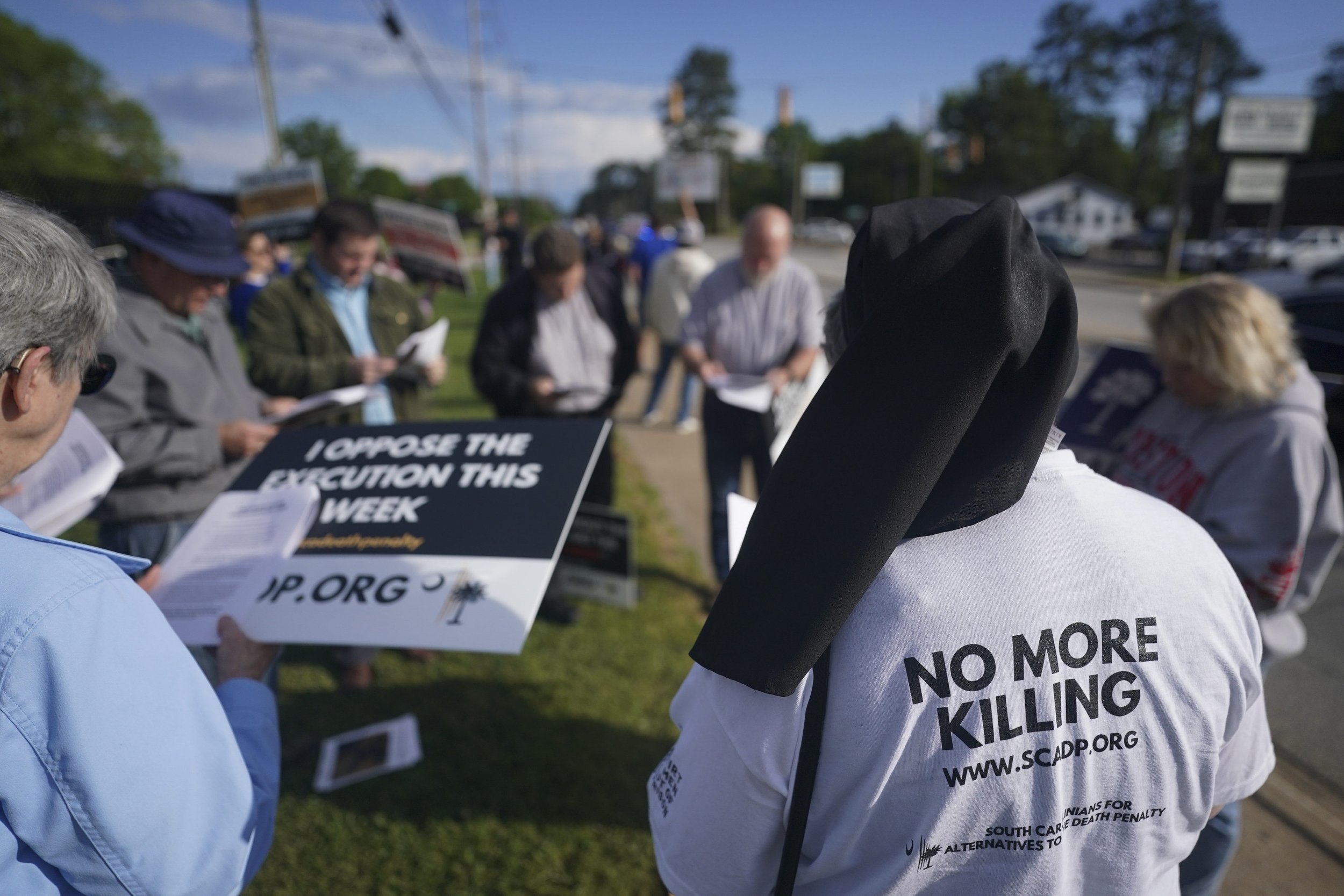Bullets mostly missed SC inmate’s heart, attorneys claim
Associated Press reporter Jeffrey Collins describes a gunshot wound on South Carolina inmate Mikal Mahdi at the department of corrections after the firing squad execution of Mahdi on April 11, 2025 in Columbia, South Carolina. Mahdi was sentenced to die 20 years ago for the killing of an off-duty police officer. His execution marks the second time in five weeks that the state carried out the death penalty by firing squad. (Photos by Sean Rayford/Getty Images)
BY: SKYLAR LAIRD
(Originally published by the SC Daily Gazette and the States Newsroom, the nation’s largest state-focused nonprofit news organization)
COLUMBIA — Bullets mostly missed an inmate’s heart during the state’s last execution by firing squad, attorneys for condemned inmates claimed in a Thursday letter to the state Supreme Court.
The court filing doesn’t ask the state’s highest court to take any action. Attorneys felt “obliged to share this information” with justices and other condemned men offered the option to die by firing squad, according to the letter, filed as a “notice of botched execution.”
Bill Scicchitano prays outside the department of corrections before the scheduled firing squad execution of South Carolina inmate Mikal Mahdi on April 11, 2025 in Columbia, South Carolina.
Three members of the media who witnessed the April 11 execution said Mahdi groaned and continued to breathe after the bullets struck him, then continued to let out periodic low moans for about 45 seconds. A doctor declared him dead about a minute after marksmen fired.
“The autopsy confirms what I saw and heard,” David Weiss, who witnessed Mahdi’s execution, said in a statement. “Mikal suffered an excruciating death. We don’t know what went wrong, but nothing about his execution was humane.”
Outside the department of corrections before the scheduled firing squad execution of South Carolina inmate Mikal Mahdi on April 11, 2025 in Columbia, South Carolina.
Under the state’s protocol, when an inmate is executed by firing squad, three marksmen fire live rounds at a target over the heart of the condemned inmate, who is strapped to a chair about 15 feet away.
Mahdi’s chest had only two bullet entry wounds, unlike the three that were clear in Brad Sigmon’s chest following his March 7 execution by firing squad.
The doctor performing the autopsy reported that to a corrections official, who suggested two of the three bullets entered in the same location, creating only two entrance wounds, according to an autopsy report.
Corrections spokeswoman Chrysti Shain reiterated that explanation in an email Thursday.
“All three weapons fired simultaneously, and all three bullets struck Mahdi,” she wrote.
Protestors outside the department of corrections before the scheduled firing squad execution of South Carolina inmate Mikal Mahdi on April 11, 2025 in Columbia, South Carolina.
The gunmen use .308 Winchester bullets, which expand and fragment on impact, according to what officials have previously told the state Supreme Court. So, an autopsy would not find whole bullets.
No fragments of bullets were discovered in the room, Shain said.
The possibility that two bullets followed the exact same path is “extraordinarily uncommon,” wrote Jonathan Arden, a pathologist hired by inmates’ attorneys to analyze the autopsy’s findings.
The bullets that struck Mahdi appeared to have hit his chest below the heart, causing more damage to his liver and pancreas than the heart itself, Arden wrote.
That’s also in contrast to Sigmon’s autopsy, which showed the bullets destroyed his heart, according to the report.
Outside the department of corrections before the scheduled firing squad execution of South Carolina inmate Mikal Mahdi on April 11, 2025 in Columbia, South Carolina.
It’s likely Mahdi “did experience excruciating conscious pain and suffering” for up to a minute after he was shot, Arden wrote.
An inmate struck directly in the heart should die within 15 seconds, he added.
“The implications of this botch are horrifying,” the Thursday court filing reads.
At his request, Mahdi’s body was cremated after the execution, the attorneys said. So, exhuming a body to learn more is not an option.
A prayer is read outside the department of corrections before the scheduled firing squad execution of South Carolina inmate Mikal Mahdi on April 11, 2025 in Columbia, South Carolina.
Attorneys also raised questions about the autopsy itself.
Mahdi’s autopsy included no close-up photos of the gunshot wounds or X-rays that might show their path, and the doctor performing the autopsy didn’t examine or document his clothing, which might have given more information about the wounds, Arden wrote.
Sigmon’s autopsy did include those details, according to the report.
“Such rigorous documentation is especially critical for deaths that carry special interest or importance, such as homicides and deaths in custody, both of which pertain to the death of Mr. Mahdi,” Arden wrote.
Attorneys have also raised concerns about executions by lethal injection. Autopsies showed that inmates’ lungs filled with fluid as they died, and they laid on the table for upwards of 20 minutes before being declared dead. Media witnesses reported that inmates stopped breathing after several minutes in each case.
Mahdi was sentenced to death in 2006 for a crime spree committed two years prior, in which he shot Capt. James Myers, an Orangeburg public safety officer, to death with his own gun after hiding out from police in Myers’ shed.
Mahdi also shot gas station clerk Christopher Boggs to death in Winston-Salem, North Carolina, and stole multiple cars during his 10-day flight from Virginia to Florida.
His execution was the fifth in the state since September, when the state resumed carrying out death sentences after an unintended 13-year hiatus. He was the second to choose to die by firing squad in state history after legislators added it as an option in 2021.
Another inmate, Stephen Stanko, is expected to be scheduled for execution in the coming weeks after running out of appeals in one of the two killings for which he was sentenced to death.






